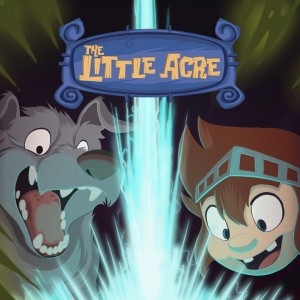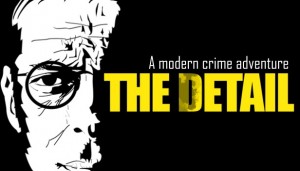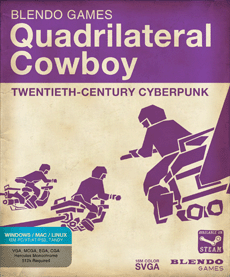Review for The Little Acre

Although The Little Acre is the debut title from Pewter Games Studios, a small group of developers from Dublin, it is a surprisingly accomplished turn at the point-and-click adventure. The name of legendary Broken Sword creator Charles Cecil appears large and proud as a producer in the credits. That would help account for some of the extra polish and expertise on display, and there are definitely a few scenes that feel inspired by Revolution’s classic series. But he came to the project fairly late in the day, so Pewter should feel proud of what they’ve accomplished by themselves. There’s certainly room for improvement, most notably in the depth of story and the overall length, but while it lasts this is a delightful fantasy adventure for all ages.
We open in an unassuming cottage in rural 1950s Ireland, with father Aidan trying to prepare for the day without actually getting out of bed or waking his daughter Lily. This acts nicely as a miniature tutorial, teaching the mechanics of left-click to interact with hotspots and using the scroll wheel to open the inventory. Once dressed, Aidan discovers that his inventor father, Arthur, is nowhere to be found, not even in the bedroom or shed where some of his odd-looking contraptions are stored. Aidan then steps into one of these machines and finds himself transported to a world completely unlike our own.
Meanwhile, Lily is finally beginning to stir and decides it’s time for her porridge, so the action switches to her. Throughout the game, control will shift automatically at set points between father and daughter. Aidan is very much the everyman, an engineer with mutton chops, a pullover and a constant concerned expression. He sharply contrasts the lively, chirpy and fearless Lily, a young girl who is quick and keen to make friends. They both make for enjoyable protagonists thanks to their disparate personalities. There are occasions where you’ll explore the same areas as both, but it’s worth clicking on everything again just to get their different reactions.
Once the important task of feeding herself is out the way, Lily soon realises her father isn’t around and gives chase into the machine. While the Irish landscape is full of rolling hills, grazing sheep and pebbled walls, the fantasy land of Clonfira offers strong juxtaposition with its alien plants, mystical symbols and purple and green colour palette. The latter is reinforced by an isometric perspective and a more cartoony aesthetic, especially in the protagonists themselves, who are suddenly depicted as stout and big-headed caricatures. Whichever world you’re in, this is a lovely visual experience. There’s a hand-painted quality to everything, with stylish background brush strokes and sketched character outlines.
What’s most noticeable is the detail that’s gone into the animation. For example, when Lily is making her porridge she ends up causing a bit of mess. The family dog, Dougal, usually in a state of wide-eyed exasperation, chases Lily round the kitchen to try to stop her from accidentally harming herself, eventually trying to catch the airborne porridge in a bowl, only for it to only splat onto his face. It’s a fun bit of slapstick, made all the better by how lively the animation is. Similar attention can be found in the smaller ambient elements, like birds flying, leaves falling and animals scurrying through the undergrowth. The Little Acre looks great in screenshots, but it’s even better in motion.
This isn’t a comedy as such, but there are jokes in both the animation and dialogue throughout that consistently land. Whether it’s Lily standing up to the garden gnome she thinks is preventing her leaving the cottage’s perimeter, a feline going up against a defensive bird, or Dougal being used as a note-holder, the humour is charming and innocent. One of my favourite moments came after I’d gone through an entire scene trying to stop a factory worker from noticing Aidan – I won’t spoil it, but the worker’s few words of dialogue that followed were unexpectedly great.
While there’s some peril, this is an adventure that will be enjoyed by all ages. You use the mouse to interact with everything, like moving your character, picking an object up or talking to someone; hotspots will highlight when you move your cursor near them. Some you can look at simply for a reaction, which I appreciated, especially those like the cottage gravestone that add titbits to the story. There’s only a small inventory and nothing can be combined. Also, a lot of the time you can only access a couple of environments at any one time. While there is a tiered hint system that can point you in the right direction, it’s doubtful that you’ll ever need to use it. This is by no means a challenging play.
There’s a puzzle near the beginning where you need to crack a code by watching Lily do a dance, which actually turned out to be one of the best because it forces you to think outside the box. Later, you’ll need to work your way across a series of small islands by summoning platforms, which had potential as a puzzle, but I frankly solved it without even thinking. Elsewhere you’ll need to get a cat to do your bidding as a distraction technique, which leads to a particularly fun moment. These all require different types of solutions, whether it’s using nearby characters to help you out or engaging an item from your inventory, which is good, but I’d have preferred to see the difficulty increase over time.
In Clonfira, it becomes your mission to find Arthur and make your way back to Ireland. Along the way, Aidan encounters a creature called Merr, who tells him that he is the last of his kind following the departure of his people a century ago, since the machines that once protected them no longer do so. The story doesn’t delve much deeper than this, remaining at surface level throughout. The crumbling, overgrown land shows advanced technology, signs of deterioration and a variety of bizarre creatures, all emphasising a sense of the otherworldly visually but under-represented in the dialogue. It would have been great to learn more about Clonfira, its species, and Arthur’s role within this world, but it never really happens.
This problem is compounded by the game’s incredibly short running time. You’ll comfortably get through this adventure in less than two hours, which is disappointingly slight even with its budget price. There are a couple of story beats which should be impactful, but they fail to resonate because you simply haven’t learnt enough about these characters and their motivations for it to affect you. The ending feels very rushed too – I was watching the credits before I’d registered that the game was over. What I’d played was of great quality, but there wasn’t enough of it, meaning I walked away feeling simultaneously satisfied and disappointed.
Though there’s not an abundance of speaking characters in the game, what you do hear is very well done. It’s really lovely to have multiple Irish voices in the cast, an accent I’ve got a soft spot for, rather than a traditional English or American dialect. Aidan is chipper and light, though often weary from the situations he finds himself in, while Lily is more enthusiastic and bubbly. Their voices suit their personalities perfectly and really bring out and elevate the humour in some of the lines. The only dud is from Merr, whose slow speech patterns don’t take long to grate. Nor do his more threatening lines come across as particularly intimidating, perhaps a fault of the direction rather than the actor.
In Ireland, the music is twinkly and light, and while it hints at the more magical elements that are to come, it wonderfully complements the ambience of these quiet and humble surroundings, with tweeting birds and water dripping from a tap in the background. It’s one of the subtler moments, but I particularly liked the soft, slow chimes that play in Arthur’s room as a ray of sunlight beams through the window. In Clonfira, the soundtrack is often less obvious, giving space for the background audio to breathe, though the strings and bells that do come through suit the exploration and mystery taking place on screen.
I really enjoyed the time I spent with The Little Acre. It’s just a crying shame that the time was far too short. There was a lot more that could have been explored in Clonfira and Ireland alike, as both sections are equally enjoyable. There’s no denying that the artwork is uniformly great, boosted by the fun and dynamic animation, and most of the voice acting is top notch as well. I look forward to what the developer produces next, hopefully with lessons learnt and a budget that lets them more fully explore their ideas. I do recommend their debut offering, just with a degree of regret that the size of the adventure comes as advertised by its title.
WHERE CAN I DOWNLOAD The Little Acre
The Little Acre is available at:
- GOG -20%






























